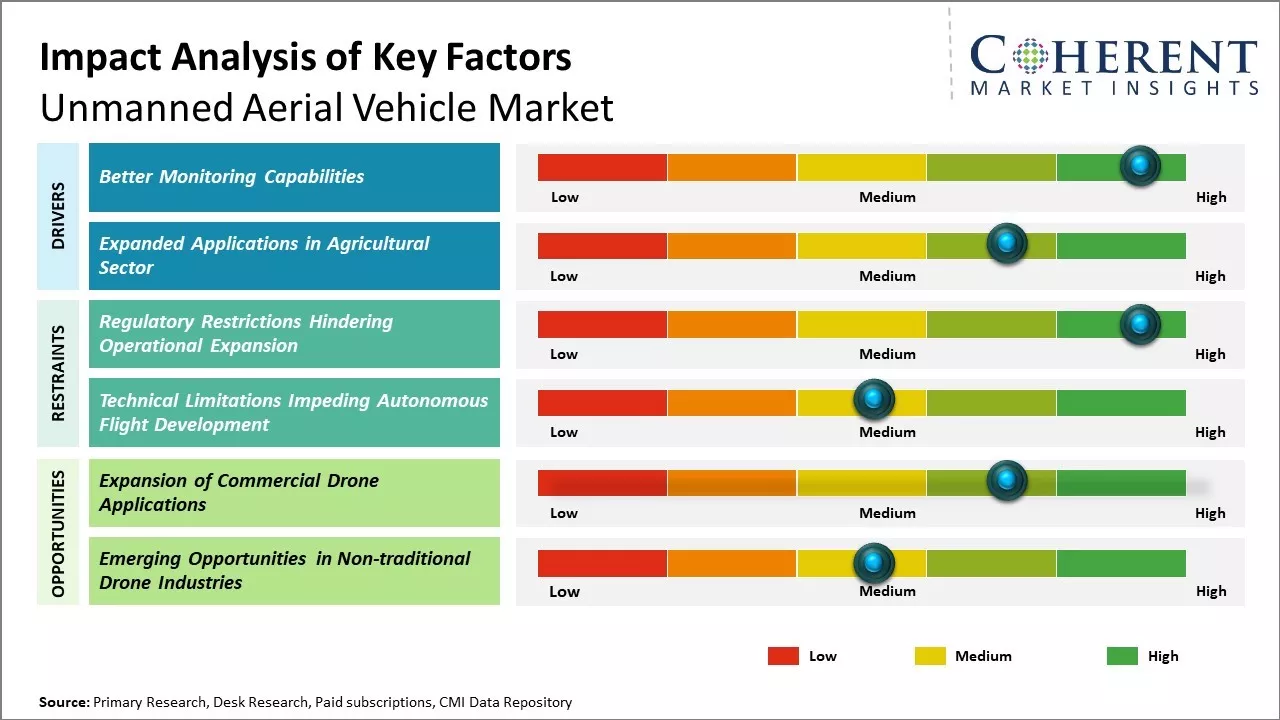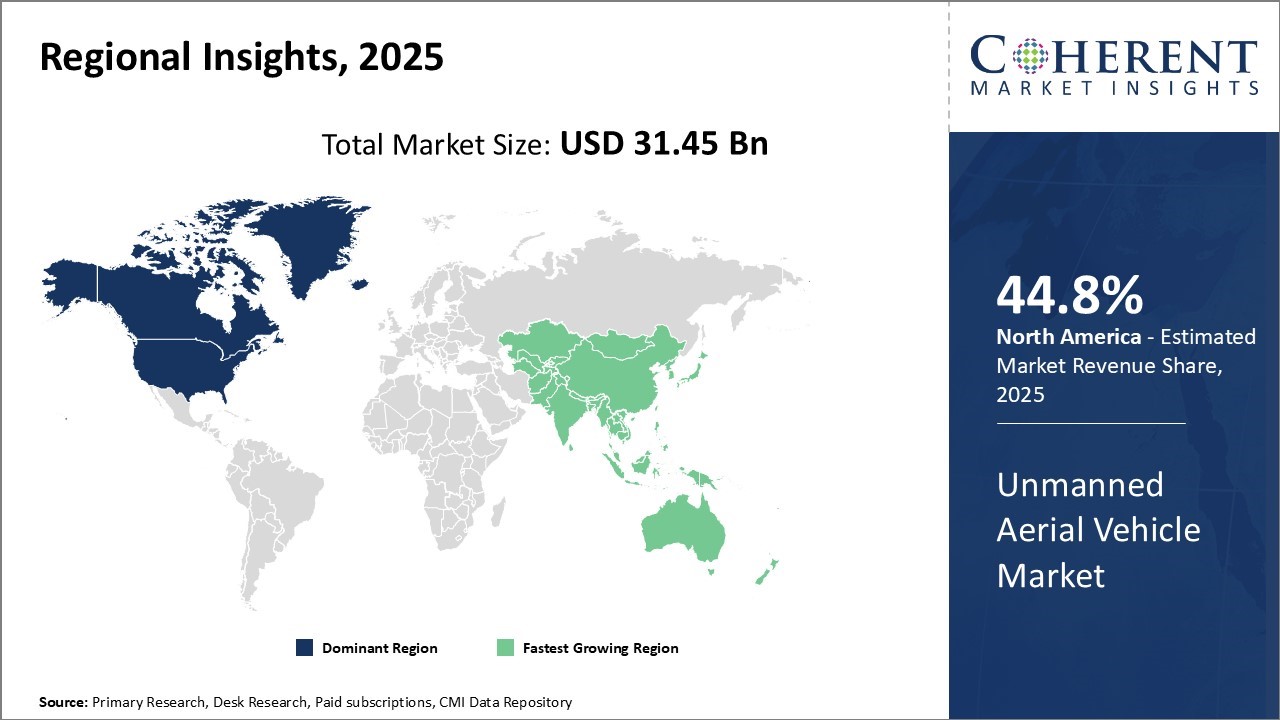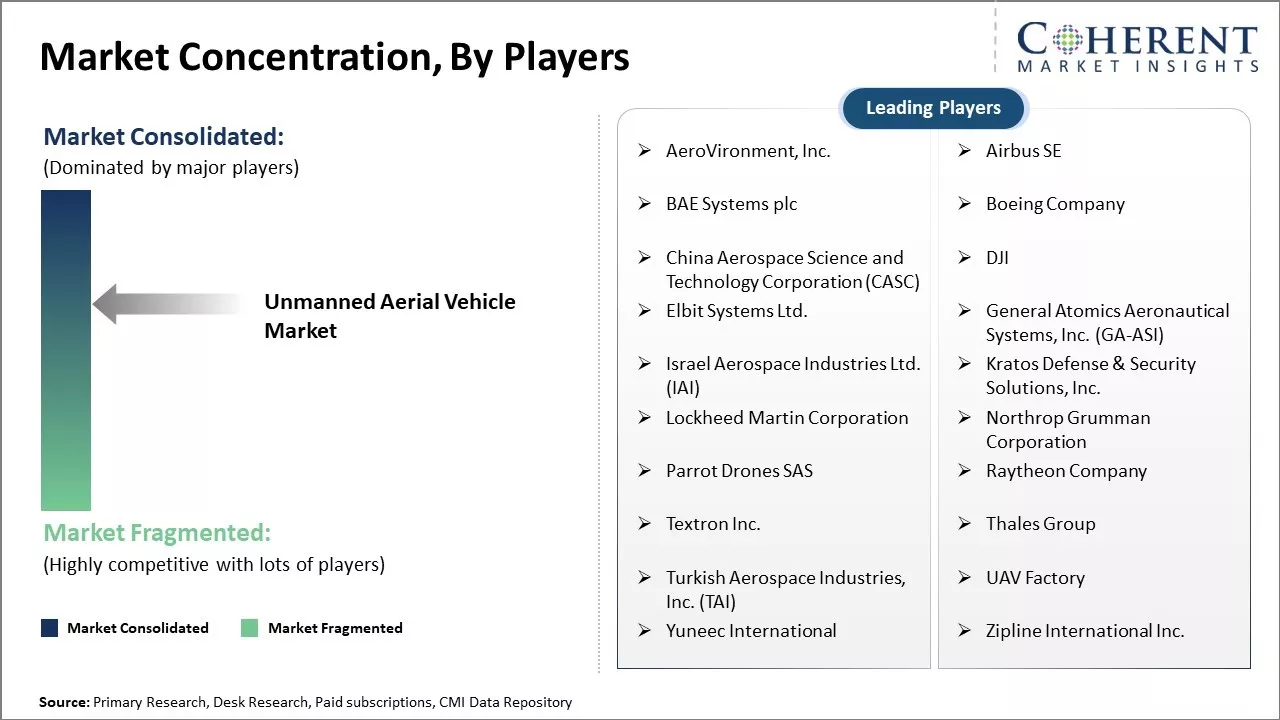The unmanned aerial vehicle market is estimated to be valued at USD 31.45 Bn in 2025 and is expected to reach USD 63.70 Bn by 2032, growing at a compound annual growth rate (CAGR) of 10.6% from 2025 to 2032.

To learn more about this report, Download Free Sample
The market is expected to witness significant growth due to increasing applications of UAVs across various commercial sectors. UAVs are increasingly being used for applications like surveying, product delivery, agriculture, inspections, and others. This growing adoption across industries like logistics, consumer goods, agriculture, etc., is expected to drive the demand for UAVs during the forecast period. Furthermore, ongoing technological advancements are making UAVs more capable in terms of payload capacity, flight time, and range. Advancements in the field of data analytics, artificial intelligence, and 5G communication are further expanding the potential uses of UAVs. Emerging applications of drone swarms and delivery drones are projected to open new avenues for unmanned aerial vehicle market growth in the coming years.
|
Current Events |
Description and its impact |
|
AI and Swarm Technology Advancements |
|
|
. Regulatory and Market Expansion Dynamics |
|
|
Battery Technology and Endurance Breakthroughs |
|
|
Geopolitical Conflict-Driven Innovation in Ukraine |
|
Uncover macros and micros vetted on 75+ parameters: Get instant access to report
Artificial Intelligence (AI) plays a transformative role in the development and operation of Unmanned Aerial Vehicles (UAVs), enhancing their autonomy, responsiveness, and effectiveness in complex environments. AI enables UAVs to process real-time data, recognize patterns, make autonomous decisions, and adapt to dynamic situations without human intervention—critical capabilities for both surveillance and combat operations.
For instance, in May 2025, Latvian defense startup Origin Robotics launched “BLAZE,” an AI-driven autonomous counter-drone system engineered to detect and neutralize fast-moving aerial threats. By leveraging AI, BLAZE offers a highly responsive and cost-effective alternative to traditional gun-based air defense systems and expensive missile interceptors. This innovation underscores AI’s growing role in modern defense technologies and positions Origin Robotics to expand its footprint in the European and NATO defense markets amid escalating regional security challenges.
Rotary blade drone is expected to contribute the highest market share of 61.2% in 2025. Rotary blade drones, commonly known as quadcopters, can vertically take off and land, hover, and move freely in any direction. This multidimensional mobility enables rotary blade drones to be deployed in a wider range of applications compared to other drone types. Their ability to hover in place allows for more precise data and image capture. The vertical take-off and landing functionality also improves accessibility to inspect areas that are difficult to reach. Rotary blade drones are particularly useful for indoor applications like warehouse inventory monitoring. Their agility also makes them well-suited for industrial inspection of infrastructure like bridges, wind turbines, and cell towers.
In October 2024, Denel Aerospace unveiled a new Rotary Wing Unmanned Aerial System (RW-UAS), specifically developed for surveillance missions. The system is designed to deliver real-time situational awareness along with high-resolution data on objects and terrain.
The sub-2 kg segment is expected to contribute the highest market share of 48.9% in 2025. Drones with payloads under 2KG generally have more basic designs and lower performance capabilities compared to heavier models. However, their smaller size and simpler components translate to more affordable price points, making them accessible to a wider consumer and commercial base. Lighter drones are suitable for hobbyists and recreational uses as well as professional applications that don't require lifted payloads. Their lower costs also appeal to applications where drones need to be replaced or upgraded frequently, such as agricultural field monitoring. As drone technology advances, sub-2 kg models continue to offer strong value, ensuring their popularity.
For instance, in Australia, as per the Civil Aviation Safety Authority (CASA) people are allowed to fly a very small drone or remotely piloted aircraft (RPA) that weighs 2 kilograms or less for work or business purposes. This is known as the "sub-2 kg excluded category" because people do not need a remote pilot licence (RePL) or a remotely piloted aircraft operator's certificate (ReOC) to fly it. Examples of people who may use drones in this category include photographers, filmmakers, real estate agents, researchers, construction workers, tradespeople, and staff from government or community service organizations. This is further proliferating the unmanned aerial vehicle market share.
Aerial photography is expected to contribute the highest market share of 33.9% in 2025. Aerial photography has become a popular method for real estate, travel, and other industries to showcase properties and destinations from an elevated viewpoint. Drone photography is also gaining favor for event coverage, surveillance, filmmaking, and other uses. The housing of high-resolution cameras on drones allows for precise image capturing over large areas in a short period. This has made aerial drones an efficient replacement for manned aircraft in applications like infrastructure inspection, survey mapping, and emergency response. Moreover, drone selfie offerings have grown aerial photography into an engaging hobby. The widespread commercial and recreational applications continue driving robust demand for drone-based aerial photography services and solutions. For instance, Garuda Aerospace introduced "Droni," a personal drone for photography enthusiasts, highlighting the growing trend of using UAVs for aerial photography.

To learn more about this report, Download Free Sample
North America has dominated the global unmanned aerial vehicle market. The region is expected to account for a market share of 44.8% in 2025. It has been the case for many years owing to strong defense budgets and early adoption of UAV technologies by the military and homeland security agencies in the U.S. and Canada. The U.S. accounts for the most prominent share of the market in the region due to heavy investments in R&D by defense organizations such as DARPA and IARPA, as well as private technology companies working in collaboration with them. Several critical UAV projects aimed at intelligence, surveillance, and reconnaissance missions are based out of facilities in the U.S., making it a leader in military drone technologies.
The presence of top UAV manufacturers like General Atomics and Northrop Grumman has also ensured that North America remains the center for the design, development, and production of high-end military UAVs. This leadership in core technologies has enabled the region to export many types of armed and unarmed drones to allies. The per capita defense expenditure in the U.S. and Canada remains higher than most other nations, allowing sustained procurement of UAVs to replace aging fleets and upgrading of platforms to incorporate the latest innovations. For instance, the US Naval Air Warfare Center Weapons Division recently tested a Solid Fuel Integral Rocket Ramjet (SFIRR) launched from a drone. This is further propelling the unmanned aerial vehicle market revenue.
The Asian market, especially China, has emerged as the fastest-growing regional market for unmanned aerial vehicles. Significant growth in the country's defense budget has translated into massive contracts for domestic UAV developers to meet military requirements. Civilian use of drones is also witnessing a boom, with e-commerce and surveillance applications driving demand. Many local manufacturers have come up who offer cost-competitive solutions compared to American and Israeli brands. For instance, SwissDrones introduced the SDO 50 V2, a multipurpose VTOL helicopter UAV, in the Asia-Pacific region, emphasizing its BVLOS capabilities and high payload capacity.
China's large drone industry is fueled by government incentives for the development of core technologies as well as a preference given to local companies in public procurements. This is enabling indigenous production to meet both military and non-military UAV needs with positive implications for import substitution. The availability of low-cost options is stimulating new applications, while export opportunities are expanding in Asia Pacific and Africa. For instance, China is also a major player in the UAV market, with the development of platforms like the TP1000, a large cargo drone capable of carrying a 1-ton payload.
The growth of the United States Unmanned Aerial Vehicle (UAV) market is supported by rising demand in areas like farming, building, and delivery services. Improvements in technology, such as longer battery life, smart navigation, and better cameras, are helping drones do more tasks. Helpful government rules and higher defense budgets are also encouraging drone use. In addition, the need for better ways to handle worker shortages, weather tracking, and emergency response is speeding up drone use in both business and defense sectors. For instance, the American company Raytheon (RTX Corporation) conducted the first helicopter launch of the Coyote LE SR, a UAV designed for reconnaissance, surveillance, electronic warfare, and more.

To learn more about this report, Download Free Sample
| Report Coverage | Details | ||
|---|---|---|---|
| Base Year: | 2024 | Market Size in 2025: | USD 31.45 Bn |
| Historical Data for: | 2020 To 2024 | Forecast Period: | 2025 To 2032 |
| Forecast Period 2025 to 2032 CAGR: | 10.6% | 2032 Value Projection: | USD 63.70 Bn |
| Geographies covered: |
|
||
| Segments covered: |
|
||
| Companies covered: |
AeroVironment, Inc., Airbus SE, BAE Systems plc, Boeing Company, China Aerospace Science and Technology Corporation (CASC), DJI, Elbit Systems Ltd., General Atomics Aeronautical Systems, Inc. (GA-ASI), Israel Aerospace Industries Ltd. (IAI), Kratos Defense & Security Solutions, Inc., Lockheed Martin Corporation, Northrop Grumman Corporation, Parrot Drones SAS, Raytheon Company, Textron Inc., Thales Group, Turkish Aerospace Industries, Inc. (TAI), UAV Factory, Yuneec International, and Zipline International Inc. |
||
| Growth Drivers: |
|
||
| Restraints & Challenges: |
|
||
Uncover macros and micros vetted on 75+ parameters: Get instant access to report
The usage of unmanned aerial vehicles provides various organizations with the ability to monitor hard-to-reach locations efficiently. UAVs equipped with cameras and other sensors allow constant monitoring of infrastructure, areas of interest without putting human lives at risk. For example, oil and gas companies routinely use drones to monitor the conditions of offshore rigs and pipelines in remote ocean locations. Similarly, government agencies responsible for border security find UAVs extremely useful for continuous surveillance of long border areas. Drones also help forest departments keep a close eye on forest fires and poaching activities. The power sector leverages drones to inspect transmission lines and wind turbines placed in mountains or offshore. The construction industry has also found drones beneficial to monitor the progress of projects situated in difficult terrains. Given their advantages over manned aircraft or helicopters in performing monitoring tasks in tough areas, more industries and agencies are expected to incorporate UAVs into their operations. This is expected to drive further demand for sophisticated multicopters and fixed-wing drones equipped with advanced cameras in the coming years.
For example, in April 2023, the Romanian government finalized an agreement valued at USD 321 million with Turkey to purchase 18 Turkish Bayraktar B2 drones, known for their advanced intelligence features and offensive capabilities. This is further accelerating the unmanned aerial vehicle market demand.
The agricultural industry is increasingly adopting unmanned aerial vehicles for a variety of precision tasks. Drones equipped with cameras and analytical software help farmers closely monitor crops and detect issues like drought, pests, or diseases at an early stage across large fields. This enables timely remedial actions and minimizes crop losses. Similarly, UAVs aid in analyzing soil health through imaging and help plan fertilizer application accordingly to boost yields. Livestock farmers also use drones to keep tabs on herd health and grazing patterns. Post-harvesting, drones are used to spray pesticides with controlled dosage in orchards, which not only saves costs but also reduces the chances of human exposure.
Furthermore, UAVs assist in irrigation management by scanning fields to identify waterlogged or dry patches requiring attention. With a growing global population increasing pressure on limited arable land, technologies enhancing agricultural productivity, resource efficiency, and sustainability are attracting major investments. Therefore, the potential of unmanned systems in revolutionizing farm management practices through optimization of inputs is expected to spur their increased uptake significantly among crop and livestock producers across the world.
For instance, as of July 2023, data from the Federal Aviation Administration (FAA) reveals nearly 900,000 drones registered in the U.S. Among these, 416,095 were designated for recreational use, while 369,528 were registered for commercial activities. Additionally, the FAA granted 331,573 remote pilot certificates, reflecting the growing number of certified drone operators.
The utilization of drones in various commercial sectors, including agriculture, infrastructure monitoring, and delivery services, offers significant growth prospects. Ongoing technological advancements are effectively tackling hurdles related to autonomy, operational range, and battery longevity, thus enhancing the feasibility and efficiency of drone operations. Additionally, the gradual harmonization of regulations on an international scale is unlocking opportunities in the global drone market, fostering broader adoption and market expansion.
*Definition: The Unmanned Aerial Vehicle (UAV) market consists of companies involved in the research, development, manufacturing, and operation of drones, commonly known as unmanned aerial vehicles (UAVs). UAVs are aircraft without a human pilot onboard and are either controlled autonomously by computers in the vehicle or controlled remotely by a pilot on the ground or in another vehicle.
Share
Share
About Author
Suraj Bhanudas Jagtap is a seasoned Senior Management Consultant with over 7 years of experience. He has served Fortune 500 companies and startups, helping clients with cross broader expansion and market entry access strategies. He has played significant role in offering strategic viewpoints and actionable insights for various client’s projects including demand analysis, and competitive analysis, identifying right channel partner among others.
Missing comfort of reading report in your local language? Find your preferred language :
Transform your Strategy with Exclusive Trending Reports :
Frequently Asked Questions
Joining thousands of companies around the world committed to making the Excellent Business Solutions.
View All Our Clients